Understanding Diamond Symmetry: A Detailed Exploration
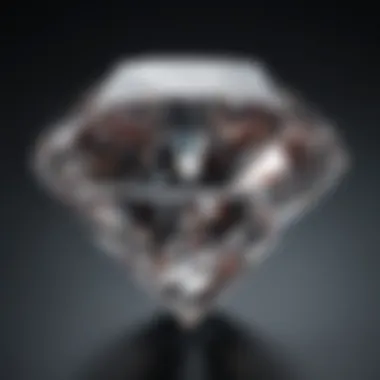

Intro
In the realm of gemstones, few capture the human imagination quite like diamonds. Their allure stems not only from their rarity but also from the myriad factors that contribute to their beauty. Among these, symmetry plays a pivotal role, often determining how a diamond reflects light and manifests its sparkle. Understanding diamond symmetry is not merely an academic exercise—it's a key component in assessing the value and desirability of these precious stones.
Throughout this discourse, we will dissect the essential aspects of symmetry in diamonds. We will explore exactly what symmetry means in this context, its classifications, and how it directly influences light performance and overall aesthetic appeal. Whether you are a collector, a jewelry designer, or just an enthusiast, grasping the nuances of diamond symmetry can empower you to make more informed choices.
Gemstone Overview
Definition and characteristics
Diamonds, a form of carbon, are renowned for their unparalleled hardness and brilliance. Defined as a precious gemstone, diamonds are often categorized based on their color, clarity, cut, and carat weight—the four critical C's that largely dictate their market value. When discussing symmetry, we are primarily concerned with how these factors come together, affecting both the light performance and viewer perception.
Diamonds possess distinct physical characteristics. Their ability to refract light, creating that brilliant sparkle, is largely a function of their cut. Cut, however, also encompasses symmetry, as it determines how well the facets align to reflect light optimally. In simple terms, a well-proportioned diamond with excellent symmetry will often outshine others with less attention to these details.
Classification of gemstones
Gemstones can be broadly classified into two categories: precious and semi-precious. Diamonds fall squarely into the precious category, alongside rubies, sapphires, and emeralds. This classification is often influenced more by historical significance and rarity than intrinsic qualities. However, within the precious sector, diamonds can be further categorized based on their origin, such as natural, synthetic, and fancy colored diamonds, which present unique symmetry criteria.
Types of Symmetry in Diamonds
Reflection Symmetry
Reflection symmetry, often observed in diamonds, ensures that each half of the diamond mirrors the other. Ideally, a well-cut diamond should exhibit bilateral symmetry when viewed from any angle. This would enhance its brilliance, making it visually appealing.
Rotational Symmetry
Rotational symmetry refers to the diamond's ability to reflect light in a circular manner. A well-proportioned diamond can rotate around its axis without losing its visual appeal. This type of symmetry is essential for the even distribution of light, contributing prominently to the 'fire' seen in quality diamonds.
"In the world of diamonds, symmetry is not just a technical term; it’s the very essence that influences the sparkle and allure of these gemstones."
Translational Symmetry
This is less commonly discussed but still significant in the world of symmetry. Translational symmetry can be observed when the diamond maintains its visual structure without alteration as it shifts position. It’s not traditionally used as a measure but adds another layer of complexity.
Understanding these types of symmetry isn’t merely an academic pursuit; it equips collectors and enthusiasts with the knowledge to discern quality in diamonds.
As we continue this exploration, we will delve deeper into the measuring techniques employed to evaluate diamond symmetry and the profound impact it has on light performance and market value.
Prolusion to Diamond Symmetry
Understanding diamond symmetry is crucial for anyone serious about gemstones. It’s not just a technical detail; it’s a window into the artistry and geometry that contribute to a diamond’s allure. Symmetry, in a gemstone context, refers to the balanced arrangement of facets, allowing for the optimal play of light, which enhances brilliance and fire. For buyers and collectors alike, grasping this concept serves several pivotal benefits.
One of the main draws to symmetry is its direct influence on the overall aesthetic appeal of a diamond. A well-balanced gemstone will reflect light in such a way that it sparkles more brilliantly than one with uneven facets. This is especially important for those looking to invest in fine jewelry. When you know the hell out of how symmetry works, you’re better equipped to select a stone that not only captures the eye but also holds its value over time.
Additionally, symmetry plays a significant role in the appraisal and grading process. Grading systems often take symmetry into account, linking it to both beauty and numerical value that collectors should be cognizant of. Understanding these nuances can prevent unintentional oversights when evaluating a piece.
In short, the study of diamond symmetry is not merely a theoretical exercise. It has real-world implications for beauty, value, and marketability. With this understanding, let’s delve deeper into what diamond symmetry actually means.
The Significance of Symmetry in Diamonds
Symmetry plays a pivotal role when it comes to the allure and valuation of diamonds. It’s not merely a trend dictated by fashion; rather, it speaks to the very foundation of what makes a diamond appealing, both visually and in terms of investment. At the heart of the diamond-buying journey, symmetry acts as a bridge connecting technical quality with aesthetic beauty.
The precise alignment and proportioning of facets create a harmony that can make or break a diamond’s appeal. It’s vital to understand that even slight flaws in symmetry can have profound effects on the overall look of a diamond. Where one may think all diamonds gleam and glimmer with equal brilliance, the reality is that symmetry impacts light performance, which directly influences one’s perception of beauty.
Impact on Appearance
The appearance of a diamond is a mosaic, composed of distinct elements that reflect light—its cut, color, clarity, and yes, symmetry. When a diamond incorporates high symmetry, this increases the chances of achieving maximum brilliance. In essence, each facet should work in unison, mirroring and reflecting light off each surface effectively.
- Visual Balance: A well-symmetrized diamond has balanced proportions which contribute to a more striking appearance, drawing the eye in and demanding attention. The relationship between different facets needs to be equivalent; imagine an orchestra where everyone plays in harmony versus a band of disjointed sounds.
- Light Dispersion: Misalignment can lead to uneven light reflection, robbing the diamond of its sparkling essence. The angles and positions of facets need to be just right; otherwise, a diamond may appear dark or dull in certain areas. Therefore, when a diamond is cut with precision, it enhances the play of light—creating that coveted ‘fire’ and ‘brilliance’ that enthusiasts admire.
With these aesthetic qualities in mind, symmetry contributes directly to the perception of beauty that collectors and jewelry designers seek. A diamond that glitters proportionately draws more admiration than a similar stone lacking in symmetry.
Influence on Market Value
When discussing the market value of diamonds, it’s essential to factor in symmetry along with the traditionally recognized Four Cs: Cut, Color, Clarity, and Carat Weight. A diamond that exhibits excellent symmetry can command prices that significantly outshine similar diamonds with only fair or poor symmetry.
- Investment Quality: Gemologists and appraisers often highlight symmetry as a critical aspect during evaluations. A diamond with exceptional symmetry not only appeals to custom buyers but also tends to age well in the marketplace.
- Market Demand: High demand exists for diamonds with superior symmetry. In a competitive marketplace where buyers are also educated about diamond features, symmetry becomes a desirable trait. Deviations in symmetry can lead to a drop in interest and price, as they are perceived as flaws by potential buyers.
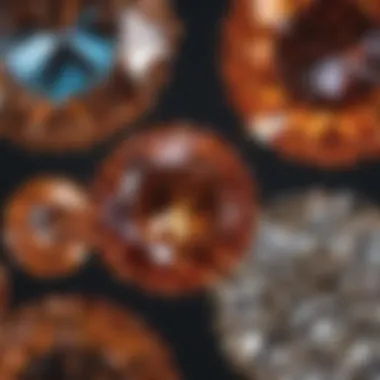

"Beauty is not just skin deep; it's cut deep. Symmetry in diamonds isn't just an aesthetic; it's a standard that aficionados trust."
In summary, the significance of symmetry in diamonds extends beyond mere appearance; it intertwines with the economic realities of the diamond market. Looking at it holistically helps both buyers and sellers understand that investing in a diamond with excellent symmetry means investing in beauty, desirability, and value.
Types of Symmetry in Diamond Cuts
Understanding the different types of symmetry in diamond cuts is key for anyone delving into the world of diamonds. Symmetry plays a pivotal role in defining a stone’s character and visual appeal. It isn't merely a technical measurement; rather, it serves as a foundation for how light interacts with the diamond, influencing everything from sparkle to perceived value. When collectors and enthusiasts appreciate a diamond, they often overlook these subtleties. Let's delve into the three principal types of symmetry that are crucial to diamond cuts: point symmetry, mirror symmetry, and rotational symmetry.
Point Symmetry
Point symmetry is a fascinating concept in which the arrangement of facets on a diamond creates a uniform balance about a central point. Imagine dropping a pin in the middle of a perfectly shaped stone. If you were to rotate the diamond, both halves would mirror each other across the point of interest, providing a sense of harmony. This type of symmetry is often most visible in popular cuts such as the round brilliant and princess cuts.
By achieving point symmetry, cutters can enhance the overall brilliance and fire of the gem, allowing it to catch light at just the right angles. A diamond lacking this symmetry can appear lopsided, diminishing its allure.
"Point symmetry ensures that each facet is positioned to complement the others, making the diamond not just a piece of jewelry but a work of art."
Benefits of Point Symmetry
- Enhanced Brilliance: Better light performance and sparkle come from well-placed facets.
- Aesthetic Appeal: A well-balanced diamond is visually more pleasing to the eye.
Mirror Symmetry
Mirror symmetry is where one-half of a diamond is a mirror image of the other half. Think of it this way: if you were to split the diamond down the center, each side would look identical. This type of symmetry is integral to both round and fancy cuts, enhancing their visual impact.
Mirror symmetry contributes to the perception of perfection. When a viewer sees a diamond with this type of symmetry, it evokes balance and equanimity. Such qualities often translate into higher market value, as gems with mirror symmetry are perceived as rare and flawless treasures.
Points to Consider with Mirror Symmetry
- Value Increase: Stones with mirror symmetry often command higher prices due to their perceived perfection.
- Demand in Design: Jewelry designers favor pieces that leverage this symmetry for stunning visual effects.
Rotational Symmetry
Rotational symmetry refers to a diamond’s ability to look the same after a certain degree of rotation. For instance, a diamond cut may look identical at 60-degree intervals when observed from above. It's an important element in cuts like the round brilliant, where uniformity is prized.
This symmetry type helps in ensuring consistent light reflection, allowing observers to see the same visual appeal from different angles. It's like a well-rehearsed dance – every turn must be on point for the performance to be captivating. In diamonds, that uniformity translates to consistent sparkle.
Key Considerations for Rotational Symmetry
- Consistent Light Performance: Enables the diamond to maintain its brilliance, no matter how it is viewed.
- Wider Appeal: Consumers generally prefer stones with rotational symmetry for engagement rings or statement pieces.
By recognizing how these types of symmetry interact within diamond cuts, enthusiasts and collectors can make more informed choices. The journey of understanding doesn't end here, though; each diamond tells its own story, and symmetry is just one of the vital threads that weave it together.
Measuring Diamond Symmetry
When dealing with diamonds, understanding symmetry is crucial. It’s not just about how a stone sparkles; how well it is cut can determine its overall appeal and value. Measuring diamond symmetry helps gemologists and consumers alike to assess quality and make informed decisions. A diamond with excellent symmetry not only enhances its beauty but also contributes to its market worth.
The evaluation of symmetry encompasses various methodologies that help in quantifying how closely a diamond’s facets align with one another. When symmetry is measured accurately, it reveals details about the cutter's skill, the potential durability of the stone, and how light interacts with it. This can be vital for a collector or enthusiast looking for investment pieces.
Tools and Techniques
Measuring tools for determining diamond symmetry can be as varied as the diamonds themselves. Here are a few common ones:
- Optical Comparators: These devices allow gemologists to compare a diamond's symmetry by projecting an image of the cut against a defined standard.
- Facet Analysis Software: Programs like GemCad enable detailed calculations and visualizations of a diamond’s facets, assisting in symmetry evaluation.
- Handheld Microscopes: Often used to inspect tiny details, these can reveal deviations in facet alignment that may not be visible to the naked eye.
- Aperture Gages: Utilized to assess the angles of facets precisely, this tool helps in determining how closely the diamond adheres to the ideal cut standards.
The above tools not only help to maintain consistency across evaluations but also instill confidence in the accuracy of results. Each technique has its nuances, and the choice often depends on the diamond’s characteristics as well as the evaluator's resources.
Evaluating Symmetry Grades
Evaluating symmetry grades involves a careful analysis of several factors. These grades typically range from Excellent to Poor, based on how well the facets align and reflect light.
- Excellent: Here, every facet aligns perfectly, producing a diamond that shines brightly and evenly.
- Very Good: Few minor alignment issues that may not be noticeable to the casual observer, but the brilliance is still impressive.
- Good: Clear alignment in most parts, but minor issues may be noticeable upon closer inspection, slightly affecting the sparkle.
- Fair and Poor: Significant deviations from the ideal, often resulting in diminished light performance and unattractive aesthetics.
"A diamond's quality lies not just in its carat weight but how beautifully it reflects light—a job well done by symmetry."
This grading system provides a clear framework for consumers to make informed choices. It is essential for buyers and enthusiasts to learn the systems used by different grading entities, such as the Gemological Institute of America, to understand how symmetry affects value and aesthetics. Despite variations, a good grasp of these grades means making a much better investment. Looking for a diamond with a higher symmetry grade can mean the difference between a dazzling treasure and a stone that disappoints.
In summary, measuring diamond symmetry is an intricate process that blends science with artistry. With the right tools and understanding of symmetry grades, enthusiasts can appreciate and choose diamonds that not only captivate but also stand the test of time.
Symmetry and Light Performance
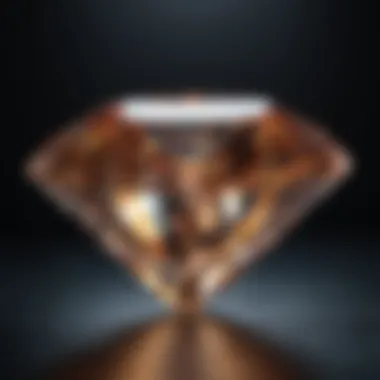
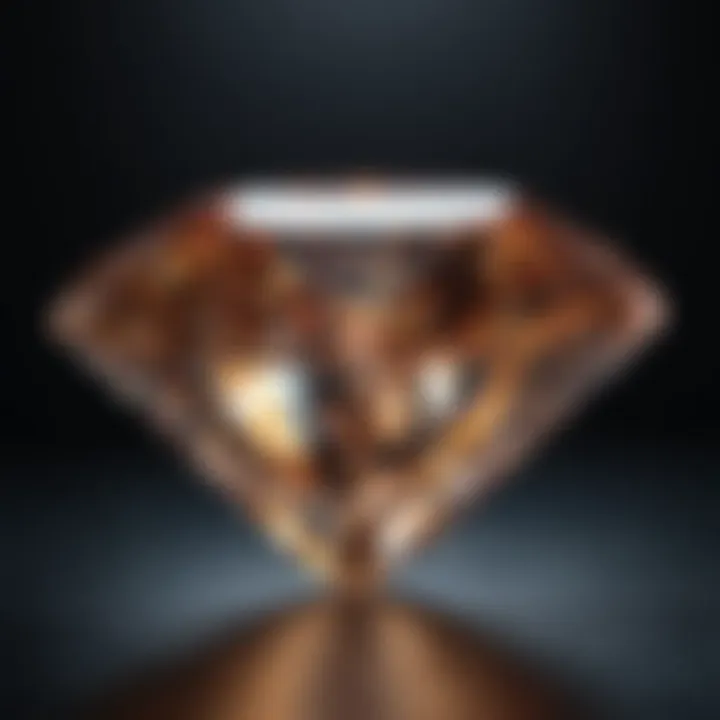
Symmetry in diamonds plays an indispensable role in how light interacts with these stones. Cutting a diamond with attention to symmetry isn’t just an aesthetic choice; it affects how light travels within the gem. When light hits a diamond, it enters, refracts, reflects, and exits in a manner that either enhances or diminishes the stone's beauty. Understanding this relationship between symmetry and light performance provides invaluable insights for gemstone enthusiasts and collectors alike.
Refraction and Reflection
In the realm of optics, refraction refers to the bending of light as it passes through different mediums. Diamonds have a high refractive index, meaning they bend light significantly. When a diamond's facets are symmetrical, the angles of incidence and reflection are consistent across the surface. This precision allows for a greater number of light rays to bounce effectively within the stone before they make their exit, leading to that captivating sparkle.
- Key factors influencing refraction include:
- Facet Angles: Even slight deviations can alter how light bends, impacting the overall brilliance.
- Facet Alignment: Misalignment may cause light to escape rather than reflect, dulling its shine.
Similarly, reflection occurs when light bounces off the surface or inner facets of a diamond. Symmetrical designs optimize reflections, creating a harmonious play of light. If a diamond is cut without symmetry, the light can exit at odd angles, leading to decreased brightness. Thus, symmetry serves as the backbone for optimal light performance, making it crucial for any quality assessment of diamonds.
"A diamond’s beauty lies not just in clarity or color, but in the dance of light orchestrated by its symmetry."
Brilliance and Fire
Two terms often thrown around in discussions about diamonds are brilliance and fire. Brilliance refers to the white light reflected by the diamond. The factors driving brilliance include the diamond’s cut, color, clarity, and especially symmetry. A well-symmetrical diamond reflects white light efficiently, resulting in a brilliant sparkle that captures attention.
Fire, on the other hand, is the dispersion of light into its component colors. With proper symmetrical cuts, diamonds can break light into a spectral rainbow, enhancing their visual allure. This angle-laden dance of light not only impresses the eye but also adds an emotional connection to a piece of jewelry.
- Guidelines for maximizing brilliance and fire:
- Cut Quality: Ensuring high symmetry aligns with the ideal cut proportions.
- Facet Configuration: Thoughtful design enhances light dispersion.
- Polish Quality: A well-polished surface helps in the reflections off the facets.
In short, without proper attention to symmetry, both brilliance and fire may lose their luster. Diamonds that exhibit both qualities not only command higher market value, but they also possess an undeniable visual appeal that resonates deeply with collectors and enthusiasts.
Common Misconceptions about Diamond Symmetry
Understanding the common misconceptions surrounding diamond symmetry is crucial for anyone who wishes to appreciate these gems fully. Often, people equate symmetry directly with perfection, which can lead to misguided judgments about the quality and value of diamonds. It is essential to clarify these misunderstandings, as doing so will help collectors, designers, and enthusiasts make informed decisions. This section addresses two specific misconceptions that frequently arise when discussing diamond symmetry, along with their implications and how they affect the overall understanding of diamond quality.
Symmetry Equals Perfection
One prevalent misconception is the belief that symmetry is synonymous with perfection in diamonds. While symmetry plays a vital role in the overall aesthetic appeal of a diamond, it does not guarantee a flawless stone. A diamond can exhibit high symmetry yet still possess inclusions or other imperfections that affect its desirability. Symmetry contributes to how light interacts with the stone, enhancing its brilliance and fire, but it is not the sole determinant of a diamond's quality.
For instance, a round brilliant cut diamond may have impeccable symmetry but still show signs of a cloud inside. This inclusiveness might detract from its beauty when viewed under magnification, even though it measures up well in symmetry. Thus, it’s crucial to evaluate diamonds holistically, considering cut quality, color, clarity, and carat weight in conjunction with symmetry.
"A diamond's beauty is a tapestry of many elements, where symmetry is just one thread."
Every Cut Requires High Symmetry
Another misconception that needs addressing is the idea that every diamond cut must exhibit high symmetry to be successful. While it’s true that symmetry is a crucial component of several popular diamond cuts, like the round brilliant or princess cut, other styles embrace asymmetry as part of their charm. Cuts such as the pear shape or marquise have distinct features where slight asymmetrical elements actually enhance their appeal.
By focusing solely on achieving high symmetry, some designers might end up sacrificing the unique characteristics that make certain cuts stand out. For instance, in vintage or antique diamonds, asymmetrical facets may contribute to a stone's character and history. Collectors seeking authenticity or a one-of-a-kind piece may prefer these non-traditional aspects, reflecting the broader spectrum of beauty that exists across different diamond cuts.
In summary, overly rigid beliefs about symmetry can limit the appreciation of the diverse world of diamond design. It’s vital to embrace the myriad perspectives on symmetry while remaining open to the notion that beauty can also exist outside conventional boundaries. A rich understanding of these misconceptions allows enthusiasts to make choices that resonate with their tastes and values, ultimately enriching their experience with diamonds.
The Role of Gemologists in Assessing Symmetry
Gemologists play a crucial role in evaluating the symmetry of diamonds. Their expertise ensures that buyers can identify high-quality stones, which not only perform well under light but also hold their value over time. Assessing symmetry is about more than just aesthetics—it's a bet on the diamond's long-lasting beauty and worth. Gemologists begin with a comprehensive understanding of various diamond cuts, paired with techniques to assess how symmetrical a diamond truly is.
Certification Processes
When it comes to assessing symmetry, one of the first steps gemologists take is to engage with certification processes. These processes are vital for establishing a standard of quality; organizations like the Gemological Institute of America (GIA) or the American Gem Society (AGS) provide unique grading systems. High-quality diamonds receive certificates outlining their characteristics, including symmetry grades.
- Visual Inspection: Gemologists begin with a visual inspection of the diamond under different lighting conditions. They utilize specialized loupes and microscopes to detect minor flaws and irregularities in symmetry that may not be visible to the untrained eye.
- Symmetry Grading: Each gemological laboratory uses its set of parameters for grading symmetry. For example, the GIA employs a scale from Excellent to Poor. This thorough evaluation helps determine how closely the diamond adheres to ideal proportions and proportions their symmetry.
- Documentation and Reporting: Ultimately, the assessment results in a certificate that documents the diamond's attributes, including symmetry grades. This document becomes an essential tool for buyers and sellers, providing transparency in the marketplace.
Expert Evaluation Techniques
The evaluation techniques gemologists apply are remarkable, blending science with seasoned artistry. Here are some common methods they employ to assess symmetry:
- Reflective Techniques: Using reflective tools, gemologists can gauge how light interacts with the diamond. This aids in observing symmetry not just visually but also functionally.
- Measurement Tools: High-tech instruments such as digital calipers enable them to measure angles precisely. Such precision helps identify deviations in symmetry that might affect overall brilliance.
- Overlay Comparison: In some cases, gemologists may use overlay patterns on the diamond's face to compare symmetry against an ideal template. This technique aids in spotting asymmetries that could detract from its perceived value.
"A diamond's beauty is not merely in its clarity or color, but in the harmony and balance established by its symmetry."
Gemologists provide invaluable insights into diamond symmetry that influence buying decisions. By ensuring diamonds are graded appropriately and assessed correctly, they help maintain a balance of aesthetic appeal and market demand.
Cultural Perspectives on Diamond Symmetry
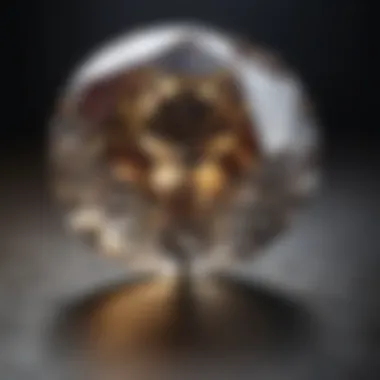
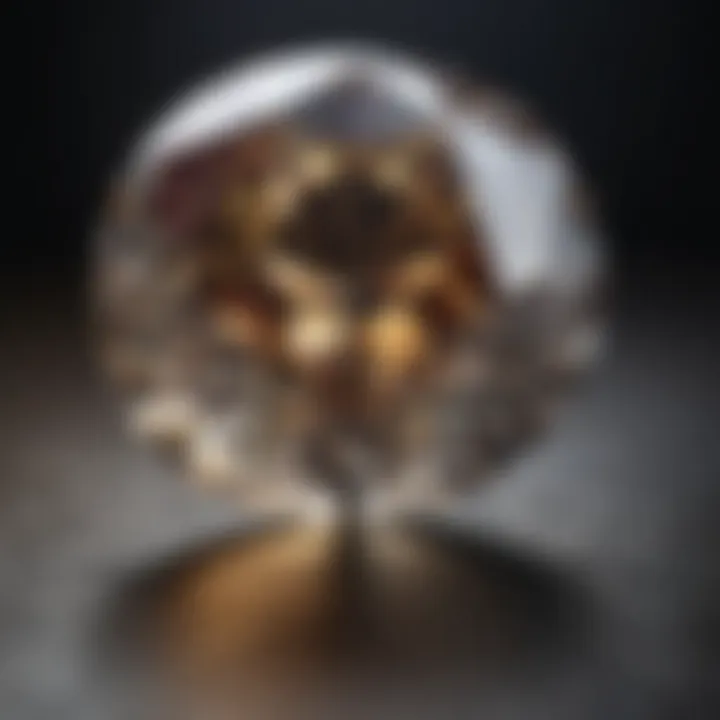
Understanding the cultural perspectives on diamond symmetry is crucial for anyone interested in the world of gemstones. It not only shapes the way diamonds are perceived but also influences buying decisions, traditions, and values associated with these precious stones around the globe.
Historical Significance
The historical significance of diamond symmetry stretches far deeper than mere aesthetics. In various ancient cultures, diamonds were seen as symbols of power and prestige. For instance, during the reign of the Mughal Empire, diamonds were intricately carved and set, showcasing mathematical precision and symmetry that hinted at wealth and authority.
Similarly, in medieval Europe, diamonds were believed to possess magical qualities. Their symmetrical facets were interpreted as a reflection of divine order. Such beliefs shaped how these gems were cut, often prioritizing symmetry as a way of aligning with nature’s perfection.
Historically, the cut of a diamond was not just a technical skill but an art form deeply rooted in the culture it emerged from. Craftsmen were often seen as artists who infused their beliefs and values into each piece. This belief still resonates today; the meticulous attention to symmetry not only enhances the diamond's visual appeal but also carries a narrative about craftsmanship and heritage.
Modern Views and Trends
In modern contexts, the conversation around diamond symmetry has evolved significantly. Today, many view diamonds as both fashion statements and investments. The perspective around symmetry has shifted to embrace not only traditional views but also contemporary trends.
For many jewelry designers, symmetry in diamonds represents not just balance but an element of timeless elegance. Brands focus on modern cuts that push the boundaries of traditional symmetry. For example, asymmetric cuts have gained traction in recent years, reflecting personal taste and individual expression. Couples often seek out unique shapes that reflect their relationship rather than the usual brilliant round or princess cuts.
But beyond the design aspect, buyers are also becoming more educated. Many people now scrutinize symmetry grades when purchasing diamonds, understanding that a well-symmetrized diamond enhances light performance and overall beauty. This growing awareness has led to greater demand for certifications from well-known institutions like the Gemological Institute of America, reinforcing the importance of symmetry within the diamond's value proposition.
"With the rise of independent gemology, consumers are more informed, understanding that symmetry plays a pivotal role in both the beauty and worth of a diamond."
Moreover, social trends and sustainability movements are influencing modern views. Buyers are more conscientious of ethical sourcing, and symmetry sometimes symbolizes the integrity of the practices used to obtain these stones.
In summary, cultural perspectives on diamond symmetry reveal a rich tapestry, from historical significance steeped in power dynamics to contemporary reinterpretations that celebrate individuality. Recognizing these facets enriches our appreciation for diamonds, making the journey of understanding symmetry not just an analytical pursuit but a narrative woven into the very fabric of the cultures that cherish them.
The Future of Diamond Symmetry
The landscape of diamond symmetry is on the brink of transformation. As technology continues to evolve, the intricate ways in which we understand and apply symmetry in diamonds is also set to change. This section captures the essence of the anticipated shifts and highlights the significance they've got for both collectors and jewelers alike.
Technological Advances
In recent years, innovations have paved the way for more precise and informative ways to assess diamond symmetry. One notable example is the use of advanced imaging technology. Systems utilizing laser scans and high-resolution cameras enable gemologists to analyze the symmetry of a diamond with unprecedented accuracy. These tools provide 3D models that detail not just the surface, but also the internal structure of diamonds.
Consider the growing use of computer algorithms that can predict light performance based on a diamond's symmetry. This technology looks at minute details that a human eye might miss, thus allowing for a more detailed grading process. Such advancements allow jewelers to set parameters that ensure high-quality cuts and symmetry, which is vital when it comes to enhancing the light performance of diamonds.
"Precision in symmetry evaluation defines the future—today's technology ensures even the tiniest blemish can be detected before a diamond hits the market."
Moreover, the concept of virtual try-ons and augmented reality applications is emerging in the jewelry retail space. Buyers can see how different symmetry styles affect their choice of a diamond, helping them make informed decisions based not just on beauty but also on the intricate mathematical arrangements of symmetry.
Emerging Trends in Design
As the ways of measuring diamond symmetry grow more sophisticated, designers are increasingly incorporating these findings into their work. This change isn’t solely about aesthetics; it is also about sustainability and ethical sourcing. There’s a noticeable move towards diamonds that not only adhere to high symmetry standards but also come from responsible sources—diamonds often lasered with unique identifiers to trace their origin.
Design trends are leaning towards cuts that accentuate and celebrate symmetry. For instance, it’s becoming common to see designs that play with different types of symmetry, merging modern styles with traditional elements. Some designers are even experimenting with uneven cuts, understanding that sometimes imperfection can pair beautifully with symmetry to create an unparalleled visual statement.
Furthermore, consumers are becoming more educated about the importance of symmetry. They’re looking for diamonds that offer not just beauty, but a promise of brilliance rooted in meticulous symmetry. This demand is pushing designers to innovate even further.
In summary, the future holds exciting avenues for diamond symmetry, marked by technological advances that refine evaluation methods and an emergence of design trends that value both beauty and ethics. As we advance, the dialogue around diamond symmetry will become richer, and those who understand and embrace the changing landscape will stand to benefit the most.
Finale: The Lasting Impact of Symmetry on Diamonds
Diamond symmetry is not merely an aesthetic consideration; it holds immense value in evaluation and market positioning. The topic of symmetry encapsulates the very essence of what makes a diamond attractive. When one thinks of diamonds, images of sparkling brilliance, intricate cuts, and flawless facets spring to mind. The truth is, symmetry plays a crucial role in nurturing these qualities and ensuring that a diamond shines to the best of its potential.
Symmetry affects how light interacts with the stone, which in turn enhances its overall beauty. When a diamond is cut with precision, its symmetry reflects light uniformly, resulting in spectacular brilliance and fire. Buyers often prioritize symmetrical stones because they can deliver that high-quality sparkle that diamond enthusiasts dream of. In many ways, symmetry serves as a silent standard by which gems are judged, influencing desirability and price alike.
The significance of symmetry is manifold:
- Aesthetic Appeal: A well-balanced diamond simply looks better. It attracts the eye and draws the onlooker in, creating a more compelling piece of jewelry.
- Market Value: Diamonds with superior symmetry generally fetch higher prices. The investment in symmetry translates into not just immediate beauty but long-term value retention.
- Consumer Confidence: A symmetric diamond often assures the buyer of quality craftsmanship, helping them feel secure in their purchase.
As we wrap this up, it is evident that the impact of symmetry extends far beyond mere visual appeal. Its intricate relationship with beauty, value, and performance cannot be understated.
Recap of Key Insights
Reflecting on the wealth of information presented, a few key insights emerge:
- Definition and Context: Understanding what diamond symmetry entails, along with its historical relevance, sets the stage for its importance.
- Impact on Value: As we explored, higher symmetry typically correlates with enhanced market values, as consumers seek reliable quality.
- Measuring Techniques: The tools and methods for evaluating symmetry can dramatically influence assessments, distinguishing good cuts from great ones.
- Common Misconceptions: It's essential to address the myths surrounding symmetry, clarifying that while it's critical, it does not equate to perfection in every context.
- Technological Advances: Innovations in the jewelry industry provide exciting implications for how symmetry is assessed and understood going forward.
With these insights in mind, it’s clear that having a thorough grasp of diamond symmetry equips enthusiasts to appreciate the gem’s full splendor. Knowledge is power, especially in the intricate world of diamonds.
Final Thoughts on Value and Aesthetics
In the realm of diamonds, where beauty meets investment, symmetry stands at a vital crossroads. As we’ve discussed, a diamond’s visual splendor hinges significantly on its symmetry. This affects not just the immediate appeal but also how the piece holds its value over time. For collectors and connoisseurs alike, understanding this relationship amplifies their appreciation of the jewelry beyond surface-level attraction.
Moreover, as individual tastes shift and evolve, it will be interesting to see how future designers adapt the principles of symmetry in their creations. Emerging trends may lead to new interpretations of traditional cuts, potentially redefining our perceptions of beauty in diamonds.
Ultimately, an informed approach to evaluating diamonds — where symmetry is a central theme — is essential for making astute decisions in purchasing and collecting. The world of diamonds is ever-changing, but the principle of symmetry will always remain a cornerstone of its allure.



